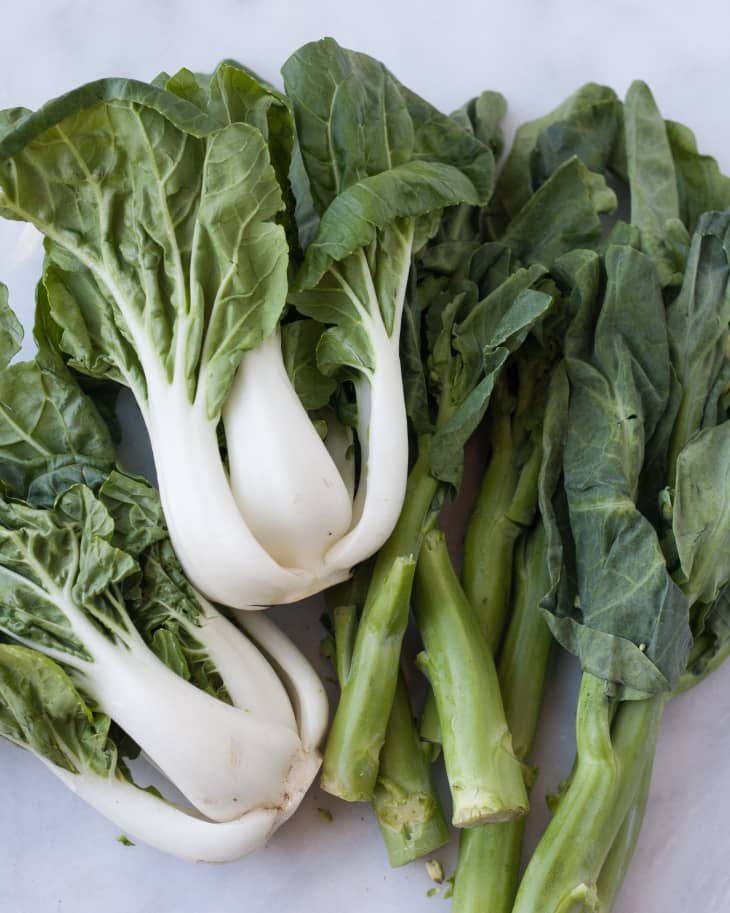A Visual Guide to 10 Varieties of Asian Greens
I love the vegetable section in Asian grocery stores because there are so many greens to choose from, especially when I’m tired of kale and chard. But for those who haven’t cooked a lot with Asian greens, the produce aisle might be a bit overwhelming, especially since the greens can go by multiple names.
1. Napa Cabbage
Also known as: Chinese cabbage
Napa cabbage is probably the most well-known, as it’s also available in non-Asian supermarkets. It’s a large vegetable with white stalks and pale green leaves arranged cruciferously. The shape is oblong. Napa has a mild taste and a soft texture when cooked, and it’s the key ingredient in Korean kimchi. Napa is best used in stir-fries and soups, but is also great eaten raw.
2. Gai Lan
Also known as: Chinese broccoli, kai lan
Gai lan is a dark-green vegetable with thick, glossy stalks, large leaves, and small yellow flower heads in the center. It’s a little more bitter than broccoli, but the stalks taste similar to broccoli stalks. It’s usually steamed and served with oyster sauce, although it can be used in stir-fries if the stalks are blanched first.
3. Pea Shoots
Also known as: Snow pea shoots, snow pea tips, snow pea leaves, pea tendrils
Snow pea shoots have hollow stems with tender leaves, and thin, wispy tendrils. They have a mild, delicate flavor and are often stir-fried with garlic, cooked in soups, or eaten raw in salads.
4. Bok Choy
Also known as: Pok choy, bok choi, Chinese white cabbage
Bok choy is a vegetable sold in either mature or baby form and is easy to find now in conventional grocery stores. Mature bok choy has white stems and dark-green leaves; baby bok choy is smaller and light-green in color. It has a mild flavor similar to chard, and is best used in stir-fries, braises, soups, and stews.
5. Yau Choy
Also known as: Yu choy sum, yu choy, yao choy, Chinese oil vegetable, sometimes labeled choy sum or choi sum (although that can technically refer to any variety of baby Chinese greens)
Yau choy (translated from Chinese to mean “oil vegetable”) has dark-green leaves and pale, thin stems, and sometimes is attached with edible yellow flowers. Use yau choy the same way as bok choy — steamed or stir-fried.
6. Gai Choy
Also known as: Chinese mustard greens, Chinese mustard, Indian mustard
Gai choy is a large vegetable that is a dark yellowish-green color. Usually some of the stems and leaves are ruffly and curled. It has a bit of a mustardy, spicy “bite” to it. Red mustard greens have a flavor similar to wasabi.
Gai choy is usually pickled, stir-fried, stewed, or braised. It’s recommended that it’s blanched first if you want to remove some of the bitterness.
7. Water Spinach
Also known as: Water spinach, Chinese water spinach, ong choy, river spinach
This tall, leafy green has hollow stems and tender leaves with a mild, sweet flavor. Unlike regular spinach, water spinach does not leave that weird coating on your teeth you when eat it. It is traditionally stir-fried with a pungent shrimp paste in Chinese cooking, but can be used in much the same way traditional spinach is used, although it does not wilt down as much and stays relatively crunchy.
8. Chinese Celery
Chinese celery looks like traditional celery, but has much thinner stalks and usually has the leafy tops attached. It has the same aroma and flavor of celery, although some say it is more intense in flavor than traditional celery. The stalks can be a bit fibrous, but Chinese celery is great in soups and stir-fries — and both the stalks and leaves are used.
9. Shanghai Bok Choy
This version of bok choy has light-green leaves and pale yellow-green stalks. It has a sweet, delicate flavor and can be used in much the same way as baby bok choy.
10. Amaranth Greens
You’re probably more familiar with amaranth seeds and flour, but the beautiful greens, which used to be seen as weeds, are edible both raw and cooked. Amaranth greens come labeled as white (although mostly green in color) or red (with red or purple streaks) varieties, contain a lot of protein, and have a delicate flavor and generally tender, hollow stems. Cook into stir fries or soups or eat raw but note that there may be a slight astringent flavor. Look for younger varieties and avoid bunches with budding flowers, which indicates maturity.
Updated from a post originally published October 22, 2009 by Kathryn Hill.
